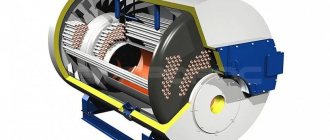For many city dwellers, a country house becomes a dream come true. However, in order for it to be as comfortable as apartments in multi-storey buildings, the owners have to work hard. If there is usually not the slightest problem with the arrangement of a water supply system, then the organization of an autonomous system for collecting wastewater often raises many questions. To create a local sewer system, many owners choose a sealed, safe, practical container - a septic tank. This treatment plant not only collects wastewater, but also filters it. But for the system to work effectively, its correct installation is important. Therefore, owners need to find out in advance what requirements apply to the construction, and how to properly install a septic tank in a private house.
What is a septic tank?
These designs appeared not so long ago. Previously, they were replaced by cesspools, in which a container was either installed or left as is. Such solutions have long been unpopular; their main disadvantages are constant soil contamination, unpleasant odors in the area, and a small volume of liquid waste that can be recycled.
A septic tank is a sealed structure consisting of several chambers connected by pipes. Its purpose is the collection and subsequent treatment of domestic wastewater. The waste liquid in this system settles, is gradually purified, and flows from one compartment to another. The greater the number of compartments, the cleaner the water becomes. Purification systems come in different types, sizes, and filtration methods may also vary slightly. The choice of structure depends on the soil on the site, on the available space, and on the desire of the owners to spend this or that amount on arranging effective cleaning.
The septic tank has several functional compartments. First, waste water enters the first chamber through sewer pipes. This is where primary settling occurs. The largest particles settle to the bottom, and fat, on the contrary, floats to the surface. Then this settled liquid flows into the second compartment. Smaller particles are filtered out in the same way. Water with a higher level of purification finally flows into a filtration well, where it is finally cleared of all impurities and then goes into the ground. Not all buildings have a third camera. It all depends on the type of construction.
Chamber volume
The volume of the chambers depends on the amount of waste that is generated during the use of plumbing fixtures installed at home. This indicator depends on the number of plumbing fixtures and the number of household members. For example, if the use of a country house is planned only in the summer, and the shower is located outside, then the volume of the chambers may be small.
If the dacha is equipped in the same way as a city apartment, then it should be assumed that each family member will spend about two hundred liters per day. So it is impossible to give a definite answer as to which septic tank is best to build in the country. The construction of a treatment plant is planned taking into account local conditions.
You should not make the chambers excessively large; a septic tank of 10 cubic meters may only be needed if the owners of several houses cooperate and build a common local sewer system.
Type of structures
Before moving on to the question of how to properly install a septic tank in a private house, you need to get acquainted with the types of structures, since there are quite a lot of options - from the simplest to the most complex, equipped with biofilters. Septic tanks are sold completely ready for installation, and their installation is usually carried out by specialists. But there are exceptions to any rule: if you get acquainted with the requirements and the order of work, then you can carry out all the stages yourself.
There are now three main types of septic tanks, they differ in the principle of operation of the system.
Cumulative
This is the simplest option, which is the basis for other types of cleaning systems. In this case, a container is used that receives liquid waste. By and large, this is the same cesspool; a sewer truck is required to empty it. This design is only suitable for houses where people do not live permanently.
If the house has a bath, shower, washing machine, then this option should not be considered. However, storage capacity may be a suitable solution if:
- there is no place on the site for a full-fledged septic tank with several compartments;
- the groundwater level is as close as possible to the surface;
- There is a source of drinking water nearby.
In these cases, installing a simple storage tank may be justified.
Septic tanks with soil treatment
These structures are no longer simple cesspools, but not yet full-fledged treatment facilities. These are overflow structures; they consist of several sealed chambers. In them, water undergoes several stages of purification to remove large and small inclusions, and then is discharged into the ground.
The cleaning process has already been described above, but instead of a filtration well, such a system may have filtration drainage fields. These are areas covered with sand and gravel, on which perforated pipes are laid. The tanks of such septic tanks require regular cleaning: at least once every 3 years, but it is better to reduce this period to 2 years.
Biological treatment systems
This is the most modern, almost perfect, environmentally friendly equipment. Water after such filtration makes it possible to use it for irrigation. The recycled liquid also does not cause the slightest harm to the environment. In such septic tanks, all the main work is done by bacteria, which decompose all unsafe substances.
Fermentation of liquid waste has 2 stages - acidic and methane. During the first stage, proteins, carbohydrates, and fats are broken down into lower acids, hydrogen sulfide, alcohols and carbon dioxide. In the second stage, substances decompose to hydrogen and methane. To remove gases into the atmosphere, bioseptic tanks must be equipped with a ventilation system.
Do-it-yourself pit preparation
The tank for the septic tank must be purchased in advance, even before work begins. The same applies to other materials. When everything you need is available, you can start digging a pit. The dimensions of the pit should be slightly larger than the dimensions of the container itself.
A sand cushion about 10 cm thick is placed at the bottom of the pit. The sand layer must be compacted and leveled so that the bottom ends up even. When the pit is ready, you can install the septic tank yourself, following all the rules for installing these structures and safety precautions.
Materials for septic tanks
To make such a cleaning system yourself, you can use concrete rings, brick, or metal. If we talk about the material of purchased models, then in this case two options are most often considered - plastic or fiberglass. However, there are also metal structures.
Concrete rings
These massive pieces are reliable and stable, which is why they often become wells and septic tanks. However, before choosing these designs, you need to know about the disadvantages. This:
Another disadvantage is the weight of concrete rings. It requires the presence of lifting equipment, and its involvement will result in additional costs.
Brick, stone
This material allows you to obtain a durable, reliable and inexpensive sump. Brickwork is constructed in the pit, then it is waterproofed using bitumen and/or cement. The downside of the material is that it takes a lot of time. Such a septic tank can also fail, since its complete tightness cannot be guaranteed.
Metal
These ready-made structures have a reasonable price, however, like concrete rings, metal septic tanks are characterized by significant weight. Due to their high thermal conductivity, metal containers require insulation. Another disadvantage is the risk of distortion and extrusion. To avoid consequences, septic tanks are installed on concrete slabs.
Plastic, fiberglass
Eurocube is the first candidate for self-manufacturing a septic tank, however, such a lightweight container requires high-quality reinforcement of the bottom and walls of the pit. Purchased designs have the same disadvantages. Fiberglass products are the best option; they are not afraid of deformation or temperature changes. But they also need an “anchor”.
Weighting the container
Despite the requirements of SNiP, it is not necessary to buy or pour a concrete slab under the container. The septic tank itself is full all the time, which means it only comes to the surface when pumped out by a sewage disposal machine. There are several methods to prevent floating:
- bury the septic tank with excavated earth mixed with sand, which will result in a sticking effect (after all, it is when using only bulk materials, in conditions of high groundwater, that the force of Archimedes becomes maximum);
- fill it completely with soil, but it is better not to do this if you want to get a long service life of more than 10 years;
- concrete the top of the barrel (for example, a two-cube septic tank requires 800-1000 kg of mixture).
Choosing a septic tank and location on the site
Even a completely sealed structure must meet safety requirements, since no one is insured against an accidental accident. Septic tanks must be located at a distance:
The structure must be at least 3 meters away from trees and bushes. This is the first answer to the question of how to properly install a septic tank in a private home.
To select the optimal system for treating household wastewater, several factors must be taken into account.
- The size of the septic tank chambers. In this case, the number of residents, plumbing fixtures, and the number of large containers (baths, pools) are taken into account.
- Possibility to do several levels of cleaning. A larger number of system tanks guarantees the safety of the site.
- Free space that can be “painlessly” allocated for settling tanks.
- Type of septic tank, its effectiveness.
If we focus on the standards, then one person produces about 200 liters of wastewater (0.2 m3) per day. This indicator is average: for example, if a tenant takes a bath (not a shower) every day, then it is better to double the norm. It's minimum.
For example, for a typical mini-family (parents and one child), the volume of the septic tank can be in the range of 1.8-3.6 m3. In this case, some reserve will not hurt, so it is better to round the numbers to 2-4 cubic meters. The capacity of all cleaning chambers does not matter. Only one is important, the first receiver compartment.
Septic tanks can be horizontal or vertical. The first ones are chosen for those areas where the groundwater level is high. The possibility of using the latter is completely excluded if they are located very close to the surface of the earth.
Laying a sewer line from the building
It is important to maintain a slope of 1-2%; too large an angle will inevitably lead to clogging and growth of fat on the walls. Of course we avoid sharp corners. It is advisable to install tees for future cleaning every 10 meters. Make the inlet pipe locally (or in advance at our factory) coaxially with the flow. Don't be lazy to use the level. With it, it’s not difficult to arrange everything correctly.
How to properly install a septic tank in a private house?
Before starting any work, it is necessary to determine which septic tank will be the optimal design for specific conditions. It is ideal to start preparing after purchasing the structure. First, markings are made on the site, then a pit and trenches are dug for laying pipes. They should have a slope of 2° per meter, this is the minimum. Then they proceed to the installation of elements of the treatment system. The last stage is checking and adjusting the operation of the equipment.
Pit preparation
Its size is selected taking into account the dimensions of the purchased septic tank. The pit should be 400-500 mm wider and 500-1000 mm deeper. The bottom of the pit must be leveled, then a layer of gravel (minimum 100 mm) and sand of the same thickness is poured. The resulting pillow is carefully compacted and the horizontal level is checked. If necessary, level it.
Since the weight of finished septic tanks is often too small, to minimize the risk of the structure “floating”, a concrete base is poured or a reinforced concrete slab is laid. With moving soils, more work is required. In this case:
Such preliminary preparation is almost always necessary for plastic containers, which are easily deformed during seasonal movements.
Installation of a sump
The procedure and features of installation depend on which design is chosen - purchased or homemade.
Ready septic tank
If you purchased a factory-made septic tank, then the work does not foretell any particular difficulties, since installing a septic tank correctly in a private house is quite simple. It is carefully lowered into the prepared pit. When necessary, the container is attached to the anchor plate. This is done in two ways: either they attach the tank with steel brackets that have anti-corrosion protection, or they use synthetic (nylon, polyester) tightening belts. The latter option is preferable, since such fastening will not be affected by an aggressive environment.
- After fixing the structure, the pit is only half filled with sand. Then the tank is filled with water, and the sand is also spilled. This stage will help prevent deformation of the container walls during operation.
- The septic tank is lined with heat-insulating material: for example, thick polystyrene foam (expanded polystyrene). The upper part of the structure is covered with a double layer, since it will be located almost on the surface of the earth.
- The next stage is installation of the pipeline. In this case, no particular difficulties arise, since the main thing is to ensure the required slope towards the septic tank. Pipe insulation is carried out if it is necessary due to the harsh climate.
If the system provides forced ventilation, then install a ventilation pipe and run a cable. Electrical wires must be protected with a corrugated pipe. The last stage is filling the structure with sand.
Sump made of concrete rings
In this case, waterproofing is laid on the gravel-sand cushion, preferably several layers. Then the ring is lowered, the reinforcement is installed and filled with mortar. A special mixture is applied to its upper edge. It consists of cement (1 part), fine sand (2) and liquid glass (0.1).
Since such a solution sets very quickly, it is prepared in small portions if the septic tank consists of a large number of rings. In case of moving soil, the rings are additionally connected with brackets. A solution is also placed on top of the second element, on which a lid is “placed”, which has a hole for ventilation and a metal hatch cover.
A concrete sump requires high-quality waterproofing. The joints from the outside are coated with a solution, then the entire surface is coated twice with hot bitumen. The last layer of external protection is roll waterproofing. On the inside, the joints of the rings are also coated with cement mortar.
Drainage system or filter well
The first type is often used for factory septic tanks, the second is a logical solution for a septic tank made of concrete rings.
Drainage field
Filtration drainage fields are considered the best alternative to a well, because they are more economical to construct, but are in no way inferior in quality of cleaning. Perforated corrugated pipes are used for filtration.
The trenches for this section are dug in such a way that their bottom is below the liquid level in the installed septic tank. This is necessary for water drainage. Geotextiles and pipes are placed at the bottom of the drainage trench. They are covered with expanded clay (gravel) on top and wrapped in fabric. The resulting cocoon is covered with earth. Such drainage must have a ventilation duct.
Filter well
The depth of this structure is about 3 meters. Geotextiles are also laid at the bottom of the pit, always with a large overlap on the walls: the height of the reserve should be equal to the height of the first ring. Then a base is made of large crushed stone and broken bricks. After this, a concrete filter ring with perforation is installed in the pit.
A solution with liquid glass is also placed on its upper part, then blind rings are installed. All joints are similarly coated with the solution. Filter materials are poured onto the bottom of the well: gravel, small stones, expanded clay residues or brick fragments. A plate is installed on top, in which there is a hatch and a ventilation hole.
Connecting additional electrical equipment
In some cases, it is necessary to connect the septic tank to electricity: when there is electrical equipment for lifting and pumping liquid between the chambers and when the chambers are equipped with aerators.
The question arises, how to connect the septic tank to electricity if you need to clean it? In some models, the drainage pump is installed inside the chamber. But it is not necessary to fix the pump in the container, since it becomes necessary to use it approximately once every 2–4 years.
This is interesting!
Autonomous sewage system for a private home: types, operating principle Read more
You can also hang a stationary pump. To do this you will need a pipe with a diameter of 32 mm. In those places where the pipe enters the container, a bend with a threaded connection is installed. This place must be sealed. The cable is connected to the pipe and fixed using plastic clamps. The cable comes out of the side wall.
Electrical equipment is under warranty. Therefore, the manufacturer’s specialists themselves configure, check and launch the autonomous cleaning system. They also regulate the power of the aerators and prepare the automatic control units for switching on. These blocks in factory septic tanks are located inside the tanks. They are accessed through the top hatches.
The owner of the site must lay a cable from the septic tank and connect it to electricity from the house. The removed cable must be insulated from moisture and damage. The cable coming out of the wall of the septic tank is sealed with a flexible coupling.
The rest of the cable is insulated with a rigid plastic corrugated pipe and laid in a prepared trench. This is a necessary measure to protect the cable from kinks, damage from stones or moisture. After this, you need to do a test run of all the equipment and then fill the trench.
Many people wonder how to properly connect a septic tank to a house, and whether or not they should equip it themselves. If the system is complex, then, without a doubt, the work should be entrusted to professionals. They will correctly calculate all the angles of inclination, digging depth, do all the work up to preparation for launch and conduct a test run.
It is almost impossible to do this on your own without errors. The slightest flaws can lead to equipment failure or other problems. You can make a sewer system with your own hands if it is planned to be simple, not equipped with pumps and other equipment.
;
Septic tank
Did you find this article helpful? Share it with your friends:
Conditions for good work
To get an effectively working septic tank, you need to pay attention to several necessary conditions.
Overflows, ventilation
Overflows should be located below the sewer pipe through which the waste flows directly into the receiver. The minimum difference is 100 mm. To ensure that the liquid is immediately directed to the lower part of the container, tees are installed at the ends of the overflows.
To ensure the flow of fresh air into the septic tank, high-quality ventilation is necessary. If there are several cameras, then it is mounted either in the first or in the last container. The minimum diameter of ventilation risers is 100 mm. The inflow must be positioned so that it is always above the surface of the wastewater. Gases are vented from the receiver through a sewer riser leading to the roof of the house. It is equipped with deflector caps.
Setup
To ensure the most efficient recycling of waste, it is necessary to provide the septic tank with microflora that will break down organic matter. The first way to find bacteria is to take sediment from an actively operating station. The optimal volume of the substance is 15% of the tank volume.
An alternative is special biological products containing aerobic, anaerobic bacteria, or bioactivators (universal, narrowly targeted), which include several types of microorganisms. The former need a good flow of fresh air, the latter can work in a closed environment.
Which septic tank is better? The answer to this question is clear: this is a factory product, durable, sealed, and maximally efficient. How to properly install a septic tank in a private house? Carry out all stages correctly. Since the efficiency of the treatment plant directly depends on the quality of installation, it is better to delegate such large-scale work to the shoulders of professionals. Or involve a friend who has already installed similar structures and therefore knows everything, or almost everything, about the process.
The following video will tell you how to choose a septic tank for your home:
Was this article helpful? We want to improve. Thanks for your opinion!
Installing the container
We lower the fiberglass septic tank onto the pre-leveled bottom. If there is water in the hole, then fill it starting from the middle section, periodically throwing the hose over the service necks in order to avoid distortion. Fiberglass partitions are load-bearing, so they will not fall when one chamber is filled to the top.
The liquid begins to flow into adjacent chambers only when it reaches the overflow. Therefore, it is necessary to fill evenly for leveling, like a boat in a lake.
If you liked the article, please share it
Previously on the topic:
Share
Exploitation
It's one thing to build a sewer system. The other is to operate correctly so that the system functions at a sufficient level.
So, let's look at how to maintain and operate a septic tank:
- Waste must be drained regularly to ensure bacterial life.
- It is prohibited to drain caustic chemicals (acids, alkalis, petroleum fluids, surfactants, etc.)
- It is necessary to periodically clean out bacterial waste products (silt deposits)
- Do not dump household waste.
If all requirements are met, such a sewer system will serve you for decades.











